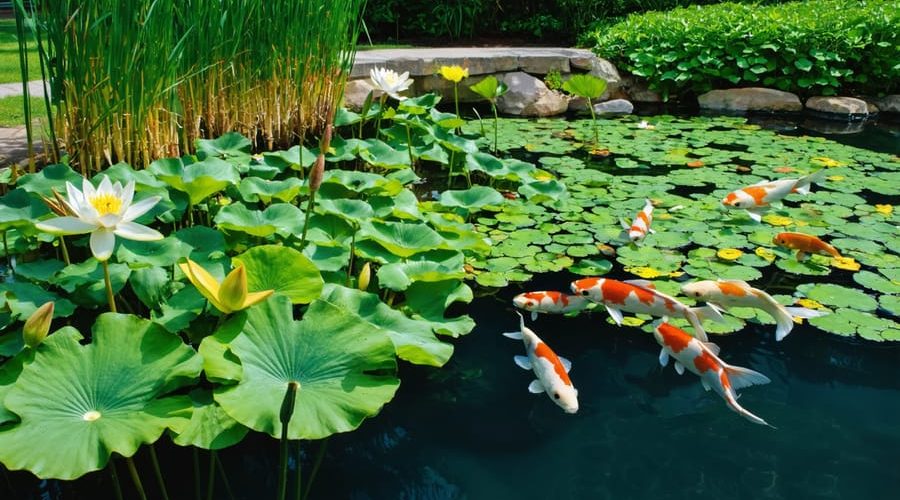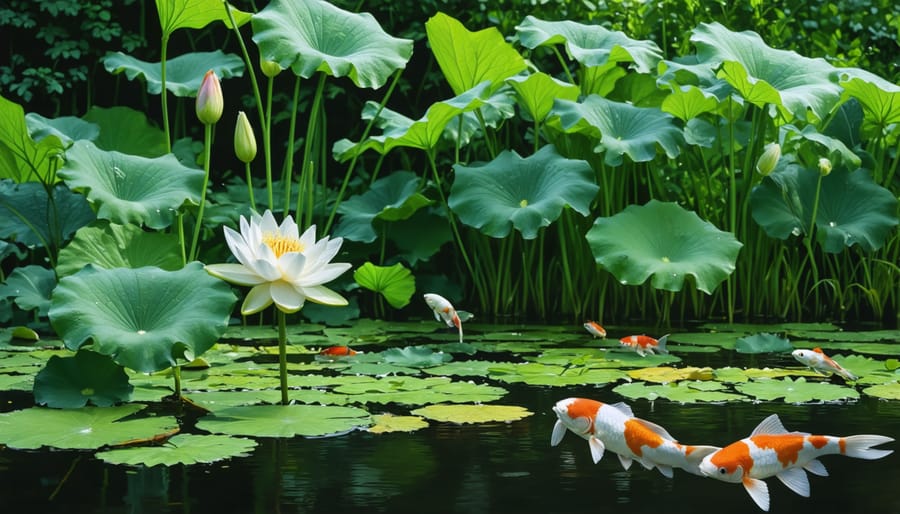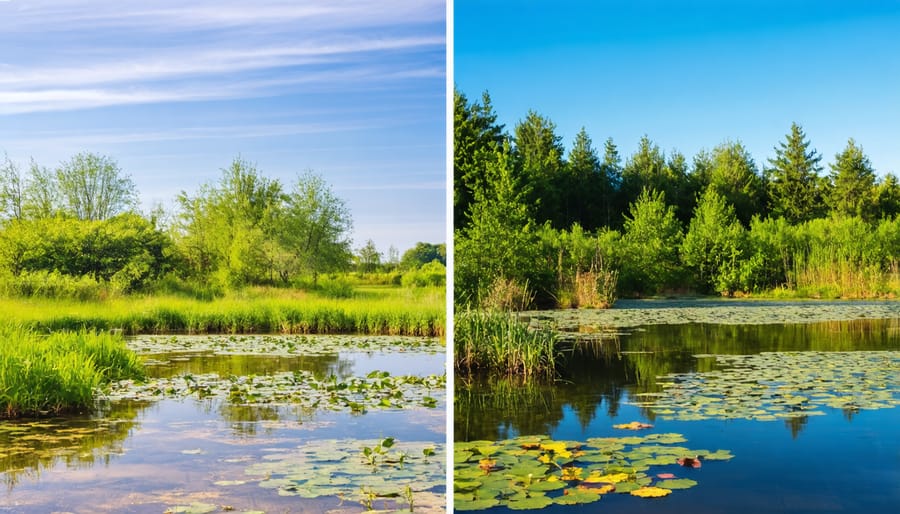
Hardy Pond Plants That Make Your Fish Thrive (Perfect Balance Guide)
Transform your pond into a thriving plant and fish ecosystem with hardy aquatic species that flourish in challenging conditions. Water lilies, rushes, and marsh marigolds anchor themselves firmly in underwater soil, naturally filtering pond water while providing essential shelter for fish. These resilient plants adapt to varying water depths, temperature fluctuations, and seasonal changes, requiring minimal maintenance once established. Native varieties like cattails and pickerelweed offer particular hardiness, establishing deep root systems that stabilize pond banks and compete effectively against invasive species. Select plants that grow in different pond zones – from deep water to marginal areas – to create a self-sustaining environment that naturally balances nutrients, reduces algae growth, and supports diverse aquatic life through all seasons.

Top Hardy Plants That Fish Love
Marginal Plants
Pond edge plants play a crucial role in creating a natural-looking water feature while helping maintain water quality and providing shelter for wildlife. These marginal plants thrive in the shallow areas around your pond’s perimeter, where they can have their roots in water but their crowns above the surface.
Popular hardy marginal plants include the striking Purple Loosestrife, which produces beautiful purple spikes in summer, and the yellow flag iris, known for its robust nature and bright blooms. Japanese Rush offers year-round architectural interest with its upright, dark green stems, while Marsh Marigold brings cheerful yellow flowers in spring.
For smaller ponds, consider compact varieties like Brooklime, which creates a lovely carpet of blue flowers, or Water Forget-me-not with its delicate baby-blue blooms. These plants not only look beautiful but also help prevent algae growth by consuming excess nutrients in the water.
When planting marginals, use aquatic baskets filled with aquatic compost and topped with gravel to prevent soil from floating away. Position plants so their crowns sit just above water level – this allows them to establish strong roots while preventing rot. Most marginal plants are best planted in spring or early summer, giving them time to establish before winter sets in.
Floating Plants
Floating plants are essential additions to any hardy pond, providing vital shade for fish and helping to maintain water quality. Water lilies reign supreme among floating varieties, with hardy varieties like ‘Attraction’ and ‘Gloriosa’ offering stunning blooms from spring through fall. These tough performers spread their leaves across the water’s surface, creating natural hiding spots for pond inhabitants while helping to control algae growth.
Another excellent choice is the water hyacinth, which forms dense mats of rounded leaves held aloft by air-filled stems. While beautiful, it’s important to check local regulations before adding these, as they can be invasive in some regions. For smaller ponds, floating heart (Nymphoides) offers charming yellow or white flowers and compact growth habits.
Water snowflake (Nymphoides cristata) provides delicate white blooms with fringed petals, while being surprisingly resilient to varying water conditions. Floating ferns like Salvinia and Azolla are also hardy choices, forming thick carpets that help reduce water evaporation and provide spawning sites for fish.
For best results, aim to cover about 60% of your pond’s surface with floating plants. This balance allows enough light penetration while maintaining adequate shade. During winter, hardy floating plants will naturally die back but return vigorously in spring, making them perfect low-maintenance choices for year-round pond beauty.
Creating the Perfect Plant-Fish Balance
Plant Coverage Guidelines
Getting the right balance of plant coverage in your pond is crucial for maintaining a healthy ecosystem. A general rule of thumb is to aim for 50-60% of your pond’s surface to be covered by plants, including both floating and marginal varieties. This coverage provides adequate shade for fish while still allowing enough sunlight penetration for underwater plants.
For small ponds (under 500 gallons), start with 3-4 marginal plants and 1-2 floating plant species. Medium-sized ponds (500-2000 gallons) can accommodate 6-8 marginal plants and 2-3 floating plant varieties. Large ponds over 2000 gallons can support 10 or more marginal plants and multiple floating plant clusters.
If you keep fish in your pond, adjust these numbers based on your fish population. For every inch of fish, provide approximately one square foot of plant coverage. Koi ponds typically need more coverage, as these fish tend to be quite active and benefit from additional hiding spots and shade.
Consider seasonal changes when planning your coverage. Some plants will grow more vigorously during summer months, so start with less coverage in spring and monitor growth. Position taller plants on the north side of your pond to prevent excessive shading of smaller varieties.
For optimal fish health, ensure there are open areas for swimming and feeding. Create planted zones in different depths, with some shallow areas for marginal plants and deeper sections for submerged varieties. This layered approach provides natural filtration while maintaining visual interest and functionality for your pond inhabitants.

Seasonal Considerations
Maintaining a healthy pond ecosystem requires different approaches throughout the year, as both plants and fish have varying needs across seasons. In spring, start by removing any dead plant material and trimming back overgrown vegetation. This is also the perfect time to divide and replant hardy species before they begin their active growth phase.
During summer, pond plants reach their peak growth and help keep algae at bay by competing for nutrients. However, be mindful not to let aggressive growers overtake the pond. Regular pruning helps maintain proper plant coverage, ideally keeping about 60% of the water surface covered with vegetation to provide adequate shade for fish.
As autumn approaches, reduce feeding your fish gradually and start removing yellowing leaves before they sink and decompose. Cut back marginal plants to about 2-3 inches above the water line, which helps prevent decay during winter months while protecting the crown of the plant.
Winter requires the most careful balance. While many hardy plants will naturally die back, their roots remain alive below the water surface. Leave dead foliage in place until spring, as it helps protect the plants from harsh winter conditions. If your pond freezes over, maintain a small opening in the ice for gas exchange, but avoid breaking the ice as this can stress both plants and fish.
Year-round, monitor water quality and adjust plant quantities as needed. Remember that a well-balanced pond typically requires less intervention, so aim to work with nature’s rhythms rather than against them. This approach ensures both your plants and fish thrive throughout the changing seasons.

Maintenance Made Simple
Regular Care Tasks
While hardy pond plants are generally low-maintenance, regular care ensures they thrive and help maintain crystal-clear pond water. Start with seasonal trimming of dead or yellowing foliage, which prevents decay from affecting water quality. During the growing season, check water levels weekly to ensure plants remain properly submerged.
Fertilization needs vary by species, but most hardy pond plants benefit from monthly feeding with aquatic plant tablets pushed into the soil near the roots. Be careful not to over-fertilize, as this can lead to algae growth. In spring, divide overcrowded plants to maintain healthy growth and prevent them from taking over your pond.
Monitor plant anchoring systems regularly, especially after storms or strong winds. Loose plants can upset pond balance and potentially damage pumps or filters. During winter, trim back marginal plants to about 2-3 inches above the water line, and move tropical varieties indoors if you live in colder regions.
Keep an eye on aggressive spreaders like cattails or water iris – while hardy, they might need containment to protect other plants’ growing space. A quick monthly inspection helps catch potential issues early, keeping your pond ecosystem healthy with minimal effort.
Problem Prevention
Maintaining hardy pond plants can be straightforward, but knowing common pitfalls helps prevent issues before they arise. One frequent problem is choosing the wrong proper plant substrate, which can lead to nutrient deficiencies and unstable growth. Always use a dedicated aquatic planting medium rather than regular garden soil.
Overcrowding is another challenge that pond gardeners often face. While it’s tempting to pack in many beautiful specimens, plants need space to grow and thrive. Plan for mature sizes and maintain proper spacing to prevent competition for nutrients and light.
Algae outbreaks can occur when there’s an imbalance in the pond ecosystem. Prevent this by ensuring about 60% of your pond’s surface is covered with plants, which naturally compete with algae for nutrients. Start with a few plants and gradually increase the number as needed.
Watch out for invasive species that can quickly take over your pond. Research local regulations and choose native or well-behaved non-native varieties. Some seemingly innocent plants can become aggressive in certain climates.
Protect against winter damage by removing dead foliage before it decomposes in the water. For cold regions, move tender plants to deeper water or bring them indoors during harsh winters. Regular monitoring helps catch potential problems early, making maintenance much easier throughout the year.
Maximizing Benefits for Both Plants and Fish
Creating a thriving pond ecosystem is all about finding the perfect balance between plants and fish. When done right, these two elements work together beautifully, each supporting the other’s health and growth. Here’s how to maximize this beneficial relationship in your pond.
First, consider the natural filtration plants provide. Water lilies and other floating plants offer shade that helps regulate water temperature and reduce algae growth, while submerged plants like hornwort actively absorb excess nutrients that fish waste produces. This natural filtration system helps maintain clearer, healthier water for your fish.
Strategic plant placement is crucial. Create different zones in your pond, with some areas densely planted to provide fish with hiding spots from predators, and other areas left open for swimming. This arrangement mimics natural habitats and reduces stress in fish, particularly during breeding seasons.
When selecting plants, choose varieties that serve multiple purposes. For example, marsh marigolds not only look beautiful but also attract insects that become natural fish food. Similarly, water iris roots provide excellent spawning areas for fish while helping to stabilize the pond’s edge.
Remember to maintain the right plant-to-fish ratio. A good rule of thumb is to cover about 60% of your pond’s surface with plants while leaving plenty of open water. This balance ensures enough oxygenation while providing adequate plant coverage for fish protection.
Feed your fish carefully to prevent excess nutrients from overwhelming your plants. When fish are overfed, uneaten food decomposes and can lead to algae blooms that compete with your hardy plants for nutrients. A well-fed fish population will naturally help control insect larvae and keep your plant growth in check.
Regularly trim dead or dying plant material to prevent it from decomposing in the water. This maintenance not only keeps your pond looking tidy but also prevents excess organic matter from affecting water quality and fish health.
Creating a thriving pond ecosystem with hardy plants is both rewarding and achievable for any garden enthusiast. By selecting the right combination of floating, marginal, and submerged plants, you can establish a self-sustaining water garden that provides beauty, functionality, and a healthy habitat for aquatic life.
Remember that successful pond gardening is all about balance. The hardy plants we’ve discussed not only add visual interest but also play crucial roles in maintaining water quality, providing shelter for fish, and controlling algae growth. From the sturdy water lilies to the practical rushes and sedges, each plant contributes to the overall health of your pond ecosystem.
Don’t be afraid to experiment with different plant combinations while keeping in mind the basic principles of pond planting. Start with a few reliable varieties and gradually expand your collection as you gain confidence. Regular maintenance, though minimal with hardy species, will help ensure your plants thrive season after season.
Whether you’re a beginner or an experienced water gardener, the key is to work with nature rather than against it. By choosing hardy plants suited to your climate and pond conditions, you’ll create a beautiful, low-maintenance water feature that brings joy throughout the year. Take the first step today in transforming your pond into a vibrant ecosystem that you can enjoy for years to come.
